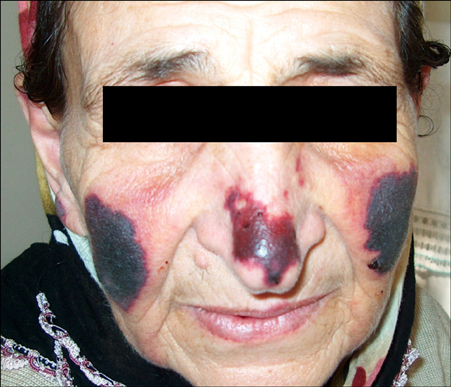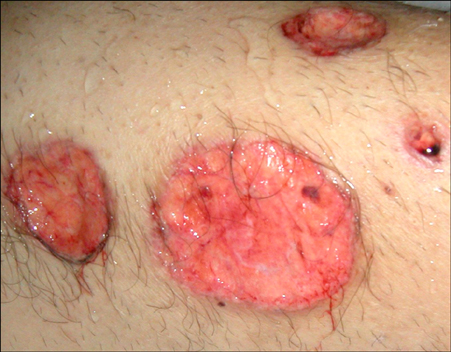Ann Dermatol.
2012 Nov;24(4):420-425. 10.5021/ad.2012.24.4.420.
Clinical Features and Etiology of Adult Patients with Fever and Rash
- Affiliations
-
- 1Department of Infectious Diseases and Clinical Microbiology, Cerrahpasa Medical Faculty, Istanbul University, Istanbul, Tutkey. rozaras@yahoo.com
- 2Department of Internal Medicine, Istanbul Education and Research Hospital, Istanbul, Tutkey.
- 3Department of Dermatology, Cerrahpasa Medical Faculty, Istanbul University, Istanbul, Tutkey.
- KMID: 2266036
- DOI: http://doi.org/10.5021/ad.2012.24.4.420
Abstract
- BACKGROUND
Patients with fever and rash often pose an urgent diagnostic and therapeutic dilemma for the clinician. The nonspecificity of many fever and rash syndromes mandates a systemic approach to diagnosis.
OBJECTIVE
We aimed to determine the etiology of fever and rash in 100 adult patients followed-up as in- or outpatients prospectively.
METHODS
All the patients, who presented with rash and fever, were followed-up prospectively and their clinical and laboratory studies were evaluated.
RESULTS
The median age was 35 years (14~79 years); 45 were female and 55 were male. Patients were divided into 3 groups according to the etiology: infectious (50%), noninfectious (40%) and undiagnosed (10%). The most common type of rash was maculopapular, and the most common 5 causes were measles, cutaneous drug reactions, varicella, adult-onset Still's disease (ASD) and rickettsial disease. Viral diseases among infectious causes and cutaneous drug reactions, among the noninfectious causes, were determined as the main diseases. The mortality rate was 5% and the reasons of mortality were as follows: toxic epidermal necrolysis (2 patients), ASD (1), staphylococcal toxic shock syndrome (1) and graft-versus-host disease (1).
CONCLUSION
Adult patients with fever and rash had a wide differential diagnosis. The most common type of rash was determined as maculopapular, and the most frequent five diseases were measles, drug reactions, chickenpox, ASD and rickettsial infection. Viral diseases among infectious causes and drug reactions among noninfectious causes were determined as the leading etiologies.
MeSH Terms
Figure
Reference
-
1. Cush JJ, Medsger TA Jr, Christy WC, Herbert DC, Cooperstein LA. Adult-onset Stills disease. Clinical course and outcome. Arthritis Rheum. 1987. 30:186–194.2. Babu KS, Belgi G. Management of cutaneous drug reactions. Curr Allergy Asthma Rep. 2002. 2:26–33.
Article3. Bachot N, Roujeau JC. Differential diagnosis of severe cutaneous drug eruptions. Am J Clin Dermatol. 2003. 4:561–572.
Article4. Sharma VK, Sethuraman G, Kumar B. Cutaneous adverse drug reactions: clinical pattern and causative agents--a 6 year series from Chandigarh, India. J Postgrad Med. 2001. 47:95–99.5. Kelkar PS, Li JT. Cephalosporin allergy. N Engl J Med. 2001. 345:804–809.
Article6. Lucchina LC, Wilson ME, Drake LA. Dermatology and the recently returned traveler: infectious diseases with dermatologic manifestations. Int J Dermatol. 1997. 36:167–181.
Article7. Todd J, Fishaut M, Kapral F, Welch T. Toxic-shock syndrome associated with phage-group-I Staphylococci. Lancet. 1978. 2:1116–1118.
Article8. The Working Group on Severe Streptococcal Infections. Defining the group A streptococcal toxic shock syndrome. Rationale and consensus definition. JAMA. 1993. 269:390–391.
- Full Text Links
- Actions
-
Cited
- CITED
-
- Close
- Share
- Similar articles
-
- Adult-onset Still's Disease as the First Manifestation of Cerebral Infarction: a Case Report
- Adult-Onset Still’s Disease with Atypical Persistent Rash and Histologic Findings of Neutrophilic Urticarial Dermatosis
- A Case of Adult-Onset Still's Disease Presented with Urticaria
- Adult Onset Still's Disesae: A Case Report
- Clinical Study on Adult Onset Still's Disease




